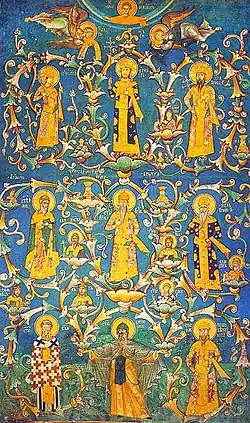Avakum the Deacon
Saint Avakum the Deacon | |
|---|---|
A mosaic icon bearing his likeness in the Church of Saint Petka in Belgrade | |
| Holy hieromartyr | |
| Born | Lepoje Prodanović 1794 Knešpolje, Ottoman Empire |
| Died | 30 December 1814 (aged 19–20) Belgrade, Ottoman Empire |
| Venerated in | Serbian Orthodox Church |
| Feast | 30 December (O.S. 17 December) |
Deacon Avakum (Serbian: Ђакон Авакум; 1794–30 December 1814) was a Serbian Orthodox monk of the Moštanica Monastery who joined Hadži-Prodan's rebellion. Suffering a martyr's death through refusing to convert, he and his associate Pajsije were proclaimed New-Martyrs (novomučenici) with commemoration on 17 December.[1] The commemoration is especially venerated in Trnava village.[1]
Avakum is the Serbian version of the Greek name Avvakoum (Αββακούμ, from Biblical Habakkuk).
Lepoje[2] or Ljepotan Prodanović[3] was born in c. 1794[4] in a village of Knešpolje[3] near the Moštanica Monastery in the Bosnia Eyalet.[4] He was educated and became a deacon under Ðenadije (or Genadije) Šuvak.[4] After pressure by Turks to pay globa (fines), Ðenadije took his son Stojan and Avakum and Avakum's mother with him to find a more peaceful place.[4] They walked across Bosnia and settled at the Trnava Monastery near Čačak, where the hegumen was Pajsije Ristović, living up until then alone.[4] They helped Pajsije with work.[4] Avakum was described as young and beautiful.[5]
After the failed First Serbian Uprising in 1813, the Ottomans began a reign of terror against the Serbs. The people decided to attempt yet another revolt, this time under Hadži-Prodan Gligorijević.[6] Among the organizers of the rebellion were the Trnava clergy of hegumen Pajsije, hieromonk Genadije, deacon Avakum and priest Radovan Vujović.[6] The rebellion was quickly suppressed, also with the help of former rebel leader Miloš Obrenović who rightly believed that it was not the right time for revolt.[6] Pajsije was impaled upon capture.[4] Some captured rebels were given the choice of converting to Islam or impalement; Genadije and his son chose conversion while Avakum refused.[7] The Turks tried to convince him, and while walking the Belgrade streets with the pole his mother stopped him and told him to save his life.[8] He was imprisoned at the Nebojša Tower.[3] The Turks tried again to convince him at the final site but Avakum refused, and seeing his fearlessness and faith they decided to pierce his heart with a knife and not impale him alive, but dead.[9]
The local school of Trnava is named after him.[1]
See also
References
- ^ a b c Erak 2017.
- ^ Protić 1968, p. 39.
- ^ a b c Kragulj 2022.
- ^ a b c d e f g Milićević 1888, p. 5.
- ^ Milićević 1888, p. 5–7.
- ^ a b c Radosavljević 2007, p. 344.
- ^ Radosavljević 2007, p. 345.
- ^ Milićević 1888, p. 6.
- ^ Milićević 1888, p. 7.
Sources
- Protić, Milisav D. (1968). Knjiga o đakonu Avakumu. Pravoslavlje.
- Erak, Nikola (2017). "Прослављени Свети новомученици Пајсије и Авакум у манастиру Трнави". Православна Епархија жичка.
- Kragulj, Dejan (2022). "Ђакон Авакум – симбол отпора". SPC.
- Milićević, Milan Đ. (1888). Поменик знаменитих људи у српског народа новијега доба. Издање Чупићеве задужбине.
- Radosavljević, Nedeljko (2007). Православна црква у Београдском пашалуку 1766-1831. Istorijski institut. ISBN 978-86-7743-065-8.
